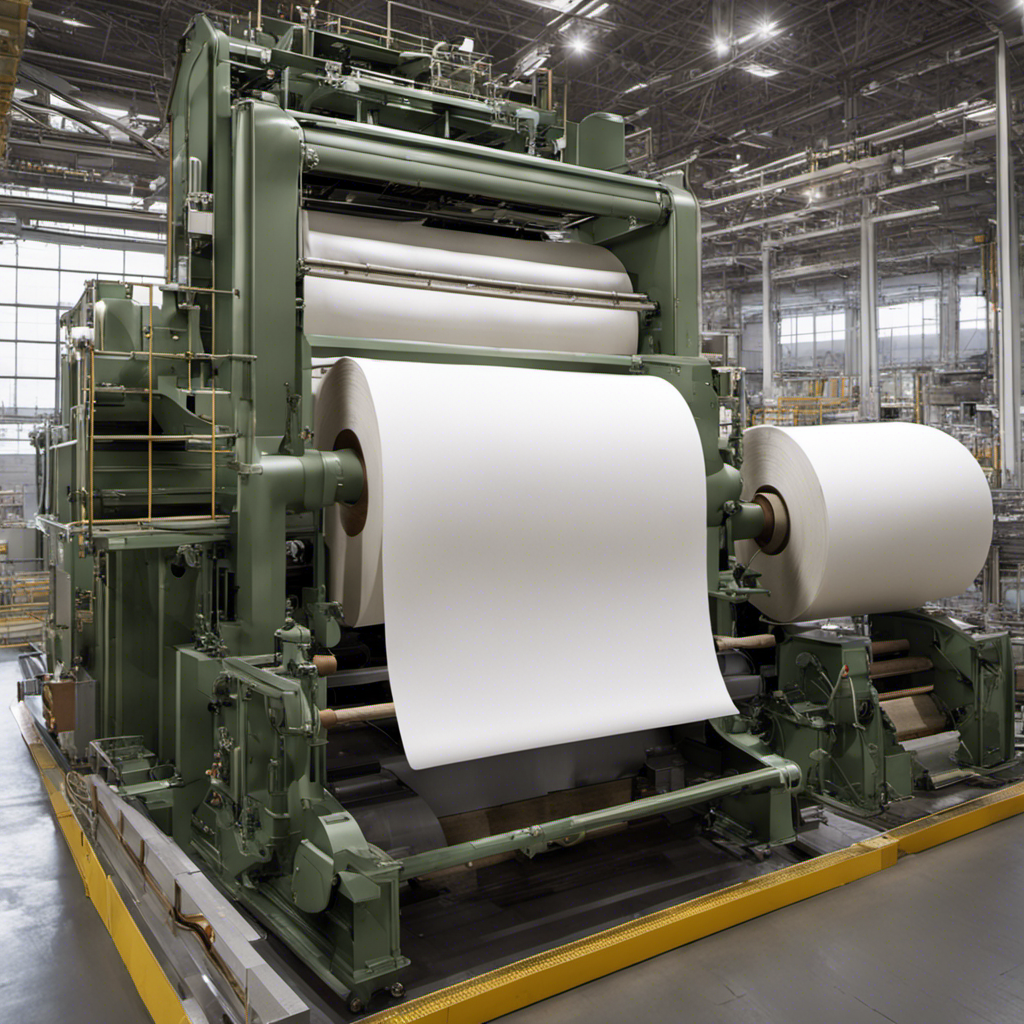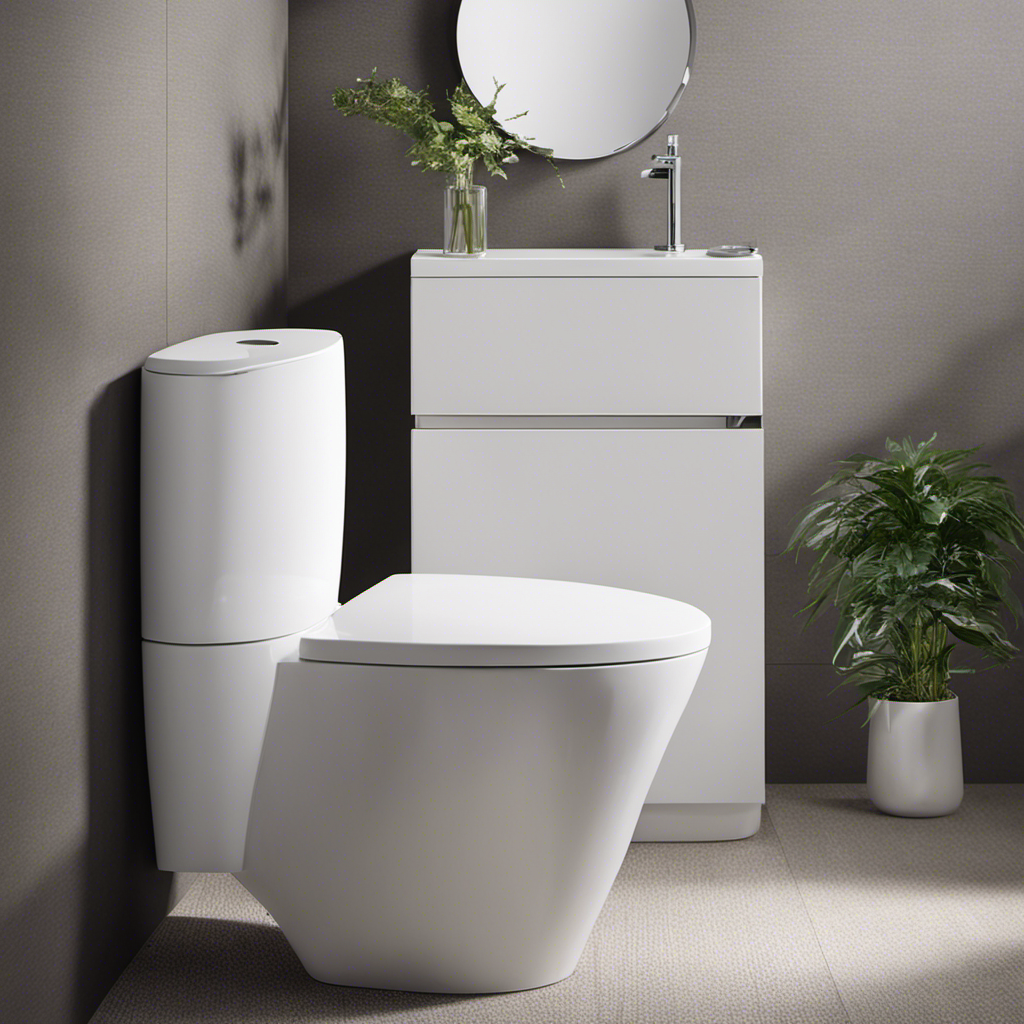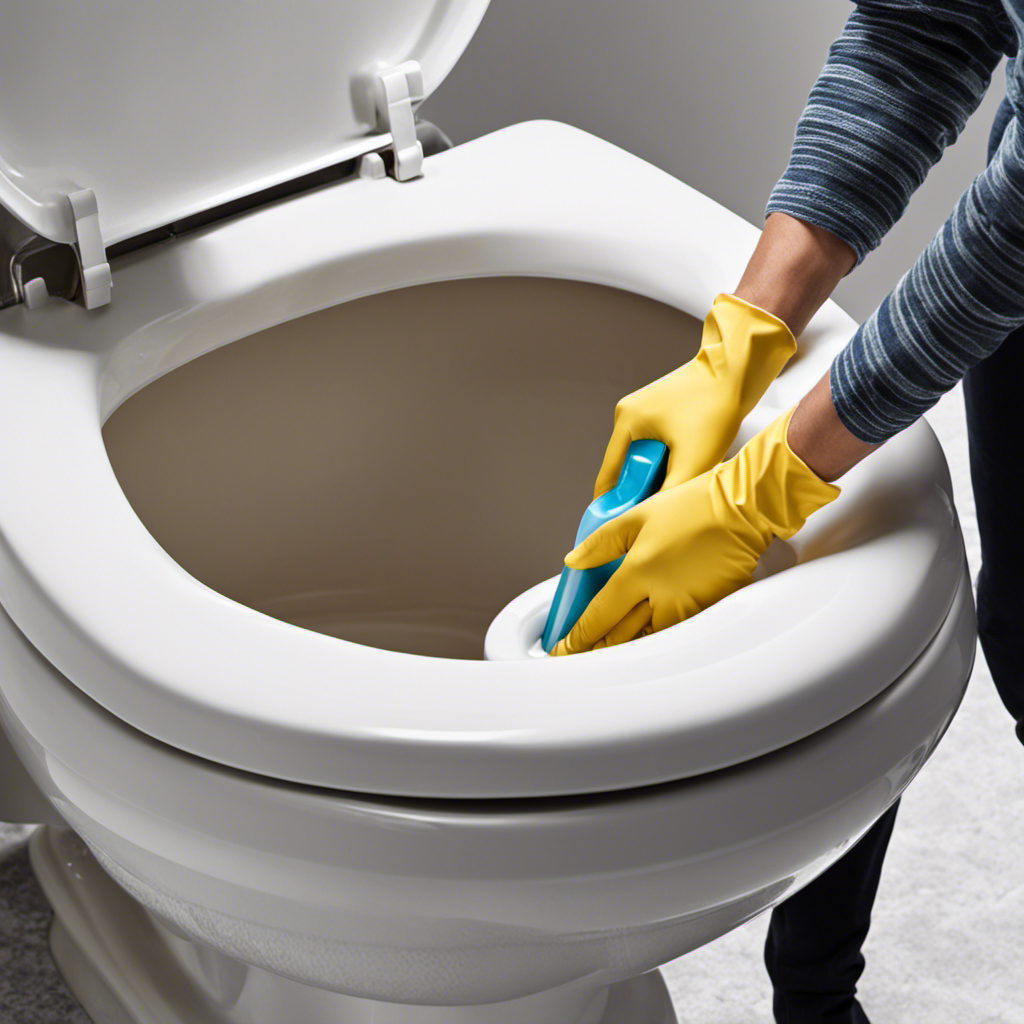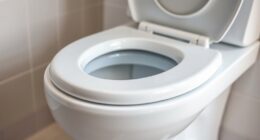Have you ever wondered how that soft, essential bathroom companion is made? Well, let me take you on a journey through the fascinating world of toilet paper production.
From its humble beginnings to the intricate manufacturing techniques used today, we will explore every step of the process.
So sit back, relax, and prepare to be amazed as we delve into the history, raw materials, papermaking process, and quality control that go into creating the perfect roll of toilet paper.
Key Takeaways
- Toilet paper production dates back to ancient China and became widely available in Europe and the United States in later centuries.
- Wood pulp is the primary raw material for toilet paper production, with some companies using alternative sources like bamboo or recycled paper.
- Toilet paper made from recycled paper reduces deforestation and has a lower environmental impact compared to virgin pulp.
- Chemical additives in toilet paper can have negative health and environmental effects, leading to a shift towards eco-friendly and chemical-free options.
The History of Toilet Paper Production
You might be surprised to learn that the history of toilet paper production dates back to ancient China. The evolution of toilet paper can be traced back to the 6th century AD, during the Tang Dynasty. At that time, toilet paper was made from soft, absorbent materials like rice straw and hemp.
The production process involved soaking these materials in water, pounding them into a pulp, and then pressing the pulp into thin sheets. These sheets were then left to dry in the sun. Over the centuries, the production methods improved, and by the 14th century, toilet paper was being mass-produced in China.
It wasn’t until the late 18th century that toilet paper production started in Europe, and in the 19th century, it became widely available in the United States. Today, toilet paper is produced using modern machinery and advanced techniques, ensuring its softness, strength, and hygiene.
Raw Materials Used in Toilet Paper Manufacturing
When it comes to the raw materials used in toilet paper manufacturing, there are three key points to consider.
Firstly, wood pulp is the primary material for toilet paper production. It is sourced from various types of trees, such as softwood and hardwood.
Secondly, recycled paper is also commonly used as a raw material to reduce the environmental impact.
Lastly, chemical additives are added to enhance the softness, strength, and absorbency of the toilet paper. However, their impact on the environment and human health should also be carefully evaluated.
Wood Pulp Sourcing
Wood pulp, which is sourced from trees, is a key ingredient in the production of toilet paper. The sourcing of wood pulp for toilet paper involves the harvesting and processing of trees. Trees are typically harvested from managed forests or tree farms, where sustainable practices are implemented to minimize the impact on the environment.
The wood is then transported to pulp mills, where it is chemically or mechanically processed to separate the fibers. This process requires a significant amount of water and energy, which can have environmental implications. However, many pulp mills have implemented measures to reduce water and energy consumption, such as recycling water and using renewable energy sources.
Additionally, some companies are now using alternative sources of fiber, such as bamboo or recycled paper, to further minimize the environmental impact of wood pulp sourcing.
Recycled Paper Usage
If you’re looking for a more eco-friendly option, consider using toilet paper made from recycled paper. Recycled paper offers many benefits and is one of the most sustainable toilet paper options available.
Here are two reasons why using toilet paper made from recycled paper is a great choice:
-
Reduced deforestation: By using recycled paper, we help reduce the demand for virgin wood pulp, which is often sourced from forests. This means fewer trees are cut down, preserving our precious forests and the habitats they support.
-
Energy and water conservation: Producing recycled paper requires less energy and water compared to making toilet paper from virgin pulp. This helps reduce the overall environmental impact of the manufacturing process.
Chemical Additives Impact
By using toilet paper with chemical additives, we may unknowingly contribute to negative effects on our health and the environment. The use of chemical additives in toilet paper is a common practice in the industry, primarily for enhancing softness, strength, and absorbency. However, there are toxicity concerns associated with these additives, as they can potentially leach into our bodies through contact with sensitive areas. Moreover, when these chemical-laden toilet papers are disposed of, they can contaminate water sources and harm aquatic life. Consumer preferences are shifting towards more eco-friendly and chemical-free options, as people become more aware of the potential risks. To provide a clearer understanding, let’s take a look at the table below, which highlights some commonly used chemical additives and their potential effects:
| Chemical Additive | Potential Effects |
|---|---|
| Fragrances | Irritation |
| Chlorine | Ecotoxicity |
| Dyes | Allergic Reactions |
| Formaldehyde | Carcinogenicity |
| BPA | Hormonal Disruption |
As we can see, there are valid concerns regarding the use of chemical additives in toilet paper. Now, let’s delve into the papermaking process for toilet paper, which will further shed light on the production and potential impacts.
The Papermaking Process for Toilet Paper
To make toilet paper, you start by breaking down the wood fibers into a pulp. This process involves several papermaking techniques that ensure the production of high-quality toilet paper. Here is a step-by-step breakdown of the toilet paper production process:
-
Wood Preparation:
-
Logs are debarked and cut into small chips.
-
The chips are then cooked in a chemical solution to remove impurities and break down lignin.
-
Pulping:
-
The chips are mechanically or chemically pulped to separate the fibers.
-
The resulting pulp is then washed and refined to achieve the desired consistency.
-
Paper Formation:
-
The pulp is mixed with water to create a slurry.
-
This slurry is then poured onto a moving wire mesh where the water is drained, and the fibers start to bond together.
-
Drying and Finishing:
-
The wet paper is pressed and dried using heated rollers.
-
It is then wound into large rolls, cut into smaller rolls, and packaged for distribution.
The Role of Water and Chemicals in Toilet Paper Production
Water usage in toilet paper production is a critical aspect that cannot be overlooked. The process involves large quantities of water, from pulping the wood fibers to diluting and dispersing the chemicals used. This raises concerns about the environmental impact, such as water scarcity and pollution.
Additionally, the use of chemical additives, such as bleaching agents and softening agents, can have detrimental effects on both human health and the environment. Therefore, it is important to explore alternative methods and materials that can reduce water usage and minimize the use of harmful chemicals in toilet paper production.
Water Usage in Production
The amount of water used in toilet paper production can be reduced by implementing more sustainable manufacturing practices. To illustrate this concept, consider the following imagery:
-
Water conservation:
-
Implementing closed-loop systems that recycle water used in the production process.
-
Utilizing advanced filtration systems to remove impurities and enable water reuse.
-
Sustainable production:
-
Incorporating more efficient machinery and technologies to minimize water usage.
-
Implementing water-saving measures, such as optimizing water pressure and flow rates.
By adopting these sustainable practices, manufacturers can significantly reduce their water consumption during toilet paper production. This not only helps conserve this precious resource but also reduces the environmental impact associated with excessive water usage.
As we explore further, it becomes evident that water reduction is just one aspect of sustainable toilet paper production. Now let’s delve into the impact of chemical additives in the manufacturing process.
Chemical Additives and Impact
If you want to minimize the environmental impact of toilet paper production, you should be aware of the potential effects of chemical additives used in the manufacturing process.
Chemical safety is a crucial aspect of toilet paper production as certain additives can have adverse health effects.
One common chemical additive used is chlorine, which is used to bleach the paper pulp and give it a white appearance. However, chlorine can release harmful compounds called dioxins, which are known to be toxic and can have long-term health effects.
Other additives like fragrances and dyes may also contain chemicals that can cause skin irritation or allergic reactions in some individuals.
Therefore, it is important to choose toilet paper that is free from harmful chemical additives to ensure the safety and well-being of both consumers and the environment.
Environmental Concerns and Alternatives
When choosing a more environmentally friendly option, you can opt for toilet paper made from recycled materials. This choice has a significantly lower environmental impact compared to traditional toilet paper production. Recycled toilet paper helps conserve natural resources by reducing the need for virgin tree pulp. It also minimizes water consumption and energy usage during manufacturing.
Recycled materials:
- Post-consumer waste: Old newspapers, magazines, and office paper are collected and processed to create recycled toilet paper.
- Pre-consumer waste: Byproducts and excess paper from manufacturing processes are repurposed to make recycled toilet paper.
By using sustainable alternatives like recycled toilet paper, we can contribute to the reduction of deforestation and waste accumulation.
Now, let’s explore the manufacturing techniques for soft and strong toilet paper.
Manufacturing Techniques for Soft and Strong Toilet Paper
One popular technique for manufacturing soft and strong toilet paper is through a process called lamination. This technique involves layering multiple sheets of paper together with adhesive to create a thicker and more durable product. Lamination is a key manufacturing technique that has revolutionized the toilet paper industry, allowing for the production of high-quality and innovative products.
To understand the benefits of lamination in toilet paper manufacturing, let’s take a look at the following table:
| Manufacturing Technique | Benefits |
|---|---|
| Lamination | – Soft and strong toilet paper – Increased durability – Enhanced comfort |
| Embossing | – Increased texture – Improved absorption – Enhanced cleaning |
| Ply bonding | – Added strength – Reduced linting – Enhanced tear resistance |
As shown in the table, lamination offers several advantages, including softness, strength, and improved durability. It allows for the creation of toilet paper that is gentle on the skin while also being strong enough to avoid tearing during use. This manufacturing technique is just one example of the product innovation that continues to drive the development of toilet paper.
Quality Control and Packaging of Toilet Paper Products
The quality control process ensures that toilet paper products meet the highest standards of softness and strength. To achieve this, we employ rigorous quality assurance measures throughout the manufacturing and packaging stages. Here’s how we ensure the exceptional quality of our toilet paper products:
-
During the production phase:
-
We conduct regular inspections of the raw materials, such as recycled paper and wood pulp, to ensure their quality and sustainability.
-
Our state-of-the-art machines carefully monitor the thickness, weight, and texture of the toilet paper as it is being manufactured, guaranteeing consistency and uniformity.
-
In the packaging phase:
-
Each roll is visually inspected to check for any defects or imperfections.
-
We use advanced packaging techniques to protect the toilet paper from moisture, dust, and other contaminants, ensuring its freshness and cleanliness.
Frequently Asked Questions
How Long Does It Take to Produce a Roll of Toilet Paper?
It takes approximately 1 to 2 hours to produce a roll of toilet paper. The toilet paper manufacturing process involves steps such as pulping, drying, rolling, and packaging. The production timeline may vary depending on the specific method and equipment used.
Is Toilet Paper Made From Recycled Materials?
Toilet paper production methods vary, but some brands use recycled materials. Alternative materials like bamboo or sugarcane fibers are also used. These options help reduce deforestation and promote sustainability in the industry.
What Are the Environmental Impacts of Toilet Paper Production?
Toilet paper production has significant environmental impacts. Deforestation is a major concern, as it contributes to habitat loss and climate change. However, there are sustainable alternatives, such as using recycled materials or bamboo, to minimize these effects.
Are There Any Health Concerns Associated With Using Toilet Paper?
There are potential health risks associated with using toilet paper, such as irritation and infection. However, there are alternatives available, like bidets and wet wipes, that can provide a hygienic option.
How Has Toilet Paper Production Evolved Over Time?
Toilet paper manufacturing techniques have evolved significantly over time. Advancements in toilet paper production have led to improvements in quality, efficiency, and sustainability. New technologies and processes have been developed to meet the growing demand for this essential product.
Conclusion
In conclusion, the intricate process of toilet paper production is truly a marvel of human ingenuity. From the carefully selected raw materials to the precise papermaking techniques, every step is taken to ensure the utmost comfort and strength of this essential bathroom item.
The use of water and chemicals adds a touch of magic, transforming ordinary paper into a silky soft and ultra-absorbent product. With rigorous quality control measures and meticulous packaging, every roll of toilet paper is ready to provide a luxurious experience for your behind.
So next time you use toilet paper, remember the incredible journey it took to reach your bathroom and appreciate the craftsmanship behind it.










